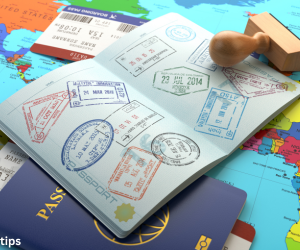Understanding Country Visas: Everything You Need to Know Before You Travel

Traveling abroad can be one of the most exciting and rewarding experiences in life. Whether you are going for holidays, businesses, studies, or a family trip, navigating the visa process is one of the most essential steps in the preparation of international travel. A visa is an official document or support that allows you to enter, live or leave a country under specific circumstances. In this guide, we will find out all the things you need to know about the visa of the country, from types and requirements to application process and tips to be approved. What is a visa? A visa is an authority given by a country government for a certain period of time and to allow a foreign national entry under specific circumstances. A visa is usually sealing or affixed to a passenger’s passport. Without the correct visa, you may be denied entry on the border, or in some cases, was overcome before riding in the flight. It is important to note that visa is not the same as entry withdrawal. Being a visa does not guarantee entry into a country. At the point of admission, the immigration officer will take a final decision on the basis of rules and regulations.
Types of Visas
Visa types
Visa comes in many shapes and forms, which is based on the purpose of your journey and the country that plan to travel. Two extensive categories of visa are non-resident visas and immigrant visas.
- Non-resident visa
These visas are for travelers who are visiting a country for temporary migration. Some common types of non-immigrant visas are included:
Tourist Visa: For those who are traveling to travel to holidays, holidays or sightseeing.
Business Visa: For persons traveling for work -related purposes, such as meetings, conferences, or business shows.
Student Visa: For those who plan to study in a school, college or university in another country.
Work Visa: For persons working temporarily in a foreign country. This type of visa may require a job offer from a company in the destination country.
Transit Visa: For those travelers who are passing through the path of another destination from a country, usually with a small migration in the country.
Family Visit Visa: For family members living in a foreign country. Depending on the country, it may include husband -wife, children, parents or other relatives.
Medical Visa: For people traveling to a foreign country to get medical treatment.
- Immigrant visa
Immigrant visas are for individuals who plan to live permanently in a country. These visas are usually more complex and require too much paperwork and processing. Types of immigrant visas include:
Family-based immigration: A visa for individuals that are sponsored by a family member who is a citizen or permanent resident of the destination country.
Employment-based immigration: For individuals who are sponsored to work by an employer and eventually settled permanently in the country.
Investor Visa: For those people who are me
How to Apply for a Visa
The visa application process can be long and detailed, requiring applicants to provide various documents and information. While the specific process may differ depending on the country you are visiting, there are common steps involved in applying for most visas.
Step 1: Determine Which Visa You Need
The first step is determining which visa you need based on the purpose of your travel. You can usually find this information on the website of the embassy or consulate of the country you plan to visit. Be clear about your travel purpose, as applying for the wrong type of visa can lead to delays or a denied application.
Step 2: Gather Required Documents
Once you’ve identified the correct visa type, you’ll need to gather the required documents. While the specific documents may vary by country, you typically need to provide:
- A valid passport: Your passport should be valid for at least six months after your planned date of entry to the country.
- Visa application form: Many countries require you to fill out an online or paper application form.
- Passport-sized photos: Countries often have specific photo requirements, such as the background color, size, and attire.
- Proof of travel plans: You may need to show flight tickets, hotel reservations, or an itinerary.
- Proof of financial stability: Some countries require proof that you can support yourself during your stay, such as bank statements, pay stubs, or tax returns.
- Travel health insurance: Some countries require travelers to show proof of health insurance coverage for the duration of their stay.
- Visa fees: Most countries require payment of a visa fee when applying. The amount varies depending on the country and visa type.
Step 3: Submit Your Application
Once you have your documents ready, you will need to submit your application. Depending on the country, you may need to submit the application:
- Online: Some countries allow online visa applications, which makes the process quicker and easier. You will typically upload scanned copies of the required documents and pay any applicable fees online.
- At the Embassy or Consulate: For most visa types, you’ll need to submit your application in person at the relevant embassy or consulate. Some countries may also allow you to use a third-party visa processing service.
- Visa Centers: Some countries have authorized visa centers where you can submit your application.
Step 4: Attend a Visa Interview (If Required)
Some countries require applicants to attend an in-person visa interview. During the interview, you may be asked about your travel plans, your financial situation, and your ties to your home country. Be prepared to answer these questions honestly and confidently. Make sure to bring any required documents with you to the interview.
Step 5: Wait for Visa Processing
After your application is submitted, you will need to wait for the visa to be processed. The processing time varies depending on the country, type of visa, and time of year. It’s essential to apply well in advance of your planned travel date to avoid any last-minute stress.
Step 6: Receive Your Visa
If your application is approved, you’ll receive your visa, either in your passport or as an electronic visa. Be sure to check the visa’s validity dates, any restrictions, and the number of entries allowed. Every nation sets its own rules for visas, and they’re all a bit different. Some places will let you get a visa right when you land at the airport or cross the border, which is called a visa-on-arrival. Others might have eVisas, where you can apply and get approved online before your trip. Plenty of countries, especially those in the Schengen Area or the European Union, have deals worked out so that once you have a visa for one, you can travel freely to others in the group.
Here are some typical visa rules for places people often visit:
United States: The U.S. has quite a few types of visas, like B1/B2 for tourists, H-1B for workers, and F-1 for students. The U.S. also runs a Visa Waiver Program (VWP) that lets people from certain countries come for up to 90 days without needing a visa at all.
European Union: The EU uses a Schengen visa, which is handy because it lets you travel to 26 European countries with just one visa. If you’re from certain countries, you can actually enter the Schengen Area without a visa for a short trip.
United Kingdom: The UK offers various…
2.United Kingdom
U.S. citizens can stay in the United Kingdom (which includes England, Scotland, Wales, and Northern Ireland) for up to six months without a visa if they’re visiting for tourism or business. Just remember to look into any extra requirements or limitations based on your reason for traveling.
Canada
For U.S. citizens, Canada is a breeze to visit. You can stay for up to six months without a visa for tourism, business, or leisure. But if you’re flying in, you’ll need an eTA (Electronic Travel Authorization), which is an online requirement for visa-exempt foreign nationals arriving by air.
Mexico
American citizens can head to Mexico without a visa for tourism or business for as long as 180 days. Even though a visa isn’t necessary, you might need to fill out a tourist card or FMM form when you arrive.
5. Japan
U.S. citizens can enjoy visa-free entry to Japan for tourism, business, or visiting loved ones, with stays permitted for up to 90 days. As a top Asian destination, Japan warmly welcomes American travelers without the need for a visa.
- Australia (eVisitor Visa)
Although a completely visa-free entry isn’t possible for U.S. citizens visiting Australia, they can easily apply online for an eVisitor visa. This process is both simple and fast, and the visa itself is free for Americans, allowing them to stay for up to 90 days for either tourism or business purposes.
- South Korea
South Korea offers U.S. citizens the convenience of visa-free stays for up to 90 days, applicable to both tourism and business trips. Furthermore, under specific circumstances, American passport holders might be able to extend their stay to a maximum of 180 days.
- Brazil
U.S. citizens are welcome to enter Brazil without a visa for tourism or business-related visits of up to 90 days. With its breathtaking landscapes and lively cities, Brazil is a captivating destination for American tourists.
9. Argentina
Argentina offers visa-free entry for U.S. citizens for stays up to 90 days. Whether you’re visiting the bustling capital of Buenos Aires or exploring the country’s natural beauty like Patagonia or Iguazu Falls, U.S. citizens can enjoy easy access.
10. Singapore
Singapore is another popular destination for U.S. citizens, who can stay for up to 90 days without a visa. The country is known for its cleanliness, modern infrastructure, and diverse cultural attractions.
11. New Zealand
U.S. citizens can travel to New Zealand for tourism or business purposes without a visa for up to 90 days. However, an NZeTA (New Zealand Electronic Travel Authority) is required for travelers arriving by air, which can be applied for online prior to your arrival.
12. Israel
Israel allows U.S. citizens to visit without a visa for up to 90 days for tourism or business. With its rich history, cultural landmarks, and religious sites, Israel is a popular destination for travelers from the U.S.
13. Thailand
Thailand is an increasingly popular travel destination for U.S. citizens. U.S. passport holders can enter Thailand visa-free for up to 30 days for tourism purposes. For stays longer than 30 days, travelers can apply for a visa extension or apply for a tourist visa in advance.
14. South Africa
South Africa permits U.S. citizens to stay for up to 90 days visa-free. The country’s diverse wildlife, beautiful coastlines, and vibrant cities like Cape Town and Johannesburg make it a fantastic destination for adventure and culture seekers.
15. Indonesia (Bali and Beyond)
U.S. citizens can visit Indonesia without a visa for up to 30 days, with the option to extend their stay for an additional 30 days while in the country. Bali, in particular, remains a top tourist destination in Indonesia.
16. Costa Rica
Costa Rica allows U.S. citizens to stay visa-free for up to 90 days. This tropical paradise in Central America is famous for its biodiversity, beaches, and eco-tourism.
17. Dominican Republic
The Dominican Republic allows U.S. citizens to enter visa-free for stays of up to 30 days for tourism. Visitors can also extend their stay for an additional 30 days.
18. Kenya (Visa on Arrival)
While Kenya requires U.S. citizens to apply for a visa, it offers visa-on-arrival or an eVisa. Travelers can easily apply for the eVisa online before departure and stay for up to 90 days.
19. Iceland
Iceland is part of the Schengen Area, so U.S. citizens can visit without a visa for up to 90 days within a 180-day period. With stunning landscapes and natural beauty, Iceland is a popular destination for nature lovers.
20. Fiji
U.S. citizens can visit Fiji visa-free for up to 4 months. It’s known for its pristine beaches, crystal-clear waters, and relaxed island lifestyle.
As a U.S. passport holder, you’re fortunate to have visa-free or visa-on-arrival access to a wide range of destinations across the globe. Whether you’re looking to explore European cities, relax on tropical beaches, or immerse yourself in culture and history, the world is full of possibilities for U.S. citizens.
Just be sure to check for any updated entry requirements or travel advisories before booking your flight, as regulations can change.
Countries That Require a Visa for U.S. Citizens Before Travel
Although U.S. passport holders enjoy extensive visa-free or visa-on-arrival privileges for travel to many countries, there are still a number of destinations where U.S. citizens must obtain a visa before entering. These visas may be required for tourism, business, or long-term stays. Here’s a list of countries where U.S. citizens need to apply for a visa in advance.
1. China
U.S. citizens planning to visit China (including mainland China, Hong Kong, and Macau) for tourism, business, or work must apply for a visa before arrival. The type of visa depends on the purpose of your trip. China’s visa application process can be lengthy, so it’s important to apply well in advance.
2. Russia
For travel to Russia, U.S. citizens need to apply for a tourist visa (or a business visa, depending on the purpose of travel). You will need an invitation letter from a Russian travel agency or hotel, and the visa application process requires submitting documents to the Russian consulate. Processing times can vary, so it’s recommended to apply at least a month before departure.
3. India
Although India offers an eVisa for U.S. citizens for tourism and business visits, travelers must apply online before their trip. The eVisa is valid for 60 days, and it’s important to note that it’s only available for certain types of visits (e.g., tourism, business, or medical purposes). If you need a longer stay or are traveling for other purposes, you must apply for a regular visa.
4. Saudi Arabia
U.S. citizens need a visa to enter Saudi Arabia for tourism, business, or other purposes. Saudi Arabia offers eVisas for tourism, which can be obtained online, but other types of visas (e.g., business, work, or student visas) require more extensive documentation and must be obtained in advance from the Saudi embassy.
5. Iran
Iran requires U.S. citizens to obtain a visa before entry. The visa application process is known to be complex and time-consuming. U.S. citizens are also required to apply through an Iranian sponsor, often a travel agency, and are typically granted visas only for tourism or specific business purposes.
6. Cuba
While the U.S. government does not currently issue tourist visas for Cuba, U.S. citizens can travel there under specific categories (such as for educational, humanitarian, or family visits). U.S. travelers must apply for a Cuban visa before departure through an authorized travel agency or the Cuban Embassy, depending on the purpose of the trip.
7. Afghanistan
U.S. citizens who plan to visit Afghanistan for tourism, business, or other purposes must apply for a visa in advance. Travelers should be aware of the security situation in Afghanistan, as it is currently not a popular destination for tourism, and there may be restrictions on travel.
8. Iraq
For U.S. citizens traveling to Iraq, a visa is required. Like Afghanistan, Iraq is not a typical tourist destination due to security concerns, but those traveling for business, humanitarian work, or specific purposes can apply for a visa. It is important to check the latest travel advisories and restrictions before applying.
9. North Korea
Traveling to North Korea is tightly controlled. U.S. citizens must apply for a visa through an approved travel agency or tour operator that has special permission to organize tours to the country. Independent travel to North Korea is not permitted, and you must be part of an organized group tour.
10. Myanmar (Burma)
U.S. citizens planning to visit Myanmar must apply for a visa before travel. Myanmar offers an eVisa for tourism and business visits, which is typically valid for 28 days. However, for other types of visits or longer stays, you will need to apply through the Myanmar embassy.
11. Nigeria
To visit Nigeria, U.S. citizens need to apply for a visa in advance. This includes a variety of visa types for tourism, business, or other purposes. The visa process for Nigeria requires submitting documents to the Nigerian consulate, and you may be asked for a yellow fever vaccination certificate as well.
12. Pakistan
Pakistan requires U.S. citizens to obtain a visa before entering the country. Depending on your purpose of travel (tourism, business, or visiting family), you will need to apply for the appropriate type of visa. The visa process can be lengthy and may require additional documentation.
13. Zimbabwe
U.S. citizens visiting Zimbabwe for tourism or business must apply for a visa before their trip, though they may also be able to obtain a visa on arrival in certain circumstances. It’s still recommended to secure your visa ahead of time to avoid complications or long waiting times.
14. Syria
Due to ongoing conflict and security concerns, Syria is not a common destination for U.S. travelers. U.S. citizens are required to apply for a visa through the Syrian Embassy, and even then, entry is subject to strict controls. The U.S. government currently advises against traveling to Syria.
15. Sudan
Sudan requires U.S. citizens to apply for a visa before traveling. Although Sudan is generally open to tourists, U.S. citizens should be aware of the political situation in the country, as there may be restrictions or safety concerns in certain regions.
16. Yemen
Yemen is another destination where U.S. citizens must apply for a visa before entry. Given the ongoing security concerns in Yemen, travel to the country is highly restricted, and U.S. citizens are strongly advised to reconsider non-essential travel to Yemen.
17. Turkmenistan
Turkmenistan is known for its strict visa requirements. U.S. citizens need to apply for a visa before traveling, and obtaining a visa requires an invitation letter from a sponsor in Turkmenistan. The application process can be time-consuming and requires careful planning.
18. Eritrea
Travelers to Eritrea must obtain a visa before arrival. The visa application process is typically handled through the Eritrean embassy or consulate. U.S. citizens may also need to provide additional documents or reasons for travel.
19. Sri Lanka (Tourist Visa)
U.S. citizens visiting Sri Lanka for tourism need to apply for an Electronic Travel Authorization (ETA) before departure. The ETA is typically valid for 30 days and can be obtained easily online. For longer stays or other types of travel, a tourist visa may be necessary.
20. Venezuela
Venezuela requires U.S. citizens to apply for a visa before travel. Due to the current political climate and economic conditions in the country, travelers should exercise caution and check the latest travel advisories.
Conclusion: Understanding Visas for International Travel
Conclusion: Understand Visa for International Travel Getting the right visa is a must for any international getaway. It can feel a little overwhelming at first, but if you get the different visa types, you know what you need for where you are going and follow the step by step, you will be ready for the next big adventure. Whether you go to work, fun, school or seeing family, having the right visa will make your journey smoother and more fun. Remember to dig into the details well before you go, get all the paperwork in order and give yourself plenty of time to get everything sorted. Although Americans can visit many places without a visa, there are still some places that need you to get approval or visa before you get there. For certain countries it may take a while to get a visa and need specific documents, so it is super important to plan ahead and double check you have checked for all the boxes. Before packing the bags, always make sure you are speeding up with the latest visa rules.




